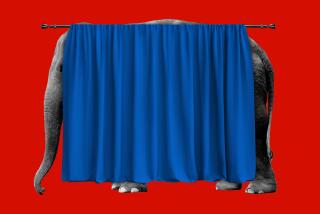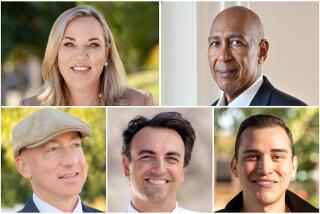Yaroslavsky opposes 2nd Latino district
In a blistering broadside, Supervisor Zev Yaroslavsky on Friday condemned proposals to create a second Latino district for the five-member Los Angeles County Board of Supervisors, making it extremely unlikely any such plan could pass and raising the possibility the politicians will fail to adopt new districts.
Yaroslavsky, in a post on his website, called the two plans for a second Latino district “a baldfaced gerrymander that is completely unnecessary.” He decried the dramatic shifts of population that would result from new district lines, saying, “The scope of the fallout would be vast and swift, potentially undermining the ability of communities to speak with one voice as advocates for their common interests.”
The five-term supervisor, who represents an area that now includes the Westside and the San Fernando Valley, asserted that the federal Voting Rights Act does not require the county to create a second Latino district, as many Latino political leaders have sought.
He noted that such districts must be drawn only when whites consistently vote together to defeat nonwhite candidates, but argued that was no longer the case in Los Angeles County. To back up his point, he cited the successes of Los Angeles Mayor Antonio Villaraigosa and Sheriff Lee Baca, who are Latino.
The demand for a second district, supported by Gloria Molina and Mark Ridley-Thomas, stems from a new demographic reality: Latinos now make up nearly half of the county population and a third of the eligible voters.
The two supervisors, a Latina and an African American, insist that districts need to be drawn to comply with federal laws protecting minority voting rights.
Thomas Saenz, president of the Mexican American Legal Defense and Educational Fund, reacted to Yaroslavsky’s comments by predicting that the county would lose a court battle if officials do not draw a new district where the majority of eligible voters are Latino. He said the courts would probably note that just 20 years ago, federal judges ruled in a similar lawsuit that the supervisors had a lengthy history of diluting Latino voting power by intentionally putting their neighborhoods into predominantly white districts to protect incumbents.
That court decision redrew district maps, paving the way for the election of Molina, the first nonwhite supervisor elected in more than a century.
Assuming that Los Angeles County is “immune from the increase in anti-Latino rhetoric that infects politics nationwide is foolish,” Saenz said.
Yaroslavsky’s decision makes it almost impossible to envision a scenario in which a second Latino district could be approved by the board. Members must muster four votes to pass any plan, a threshold that political observers have a hard time imagining the fractured body will be able to achieve.
“I think it’s going to be one of the most fascinating things that the county has done in years,” said Raphael Sonenshein, a political science professor at Cal State Fullerton. “It’s hard for me to see how this is going to work.”
Sonenshein noted that Yaroslavsky is a member of two overlapping majorities — white supervisors and Democratic supervisors — and could play a pivotal role in negotiations toward a compromise, but added, “I’m not sure he would benefit himself by appointing himself as the solution.”
If the board cannot reach a decision by Oct. 31, then three county officials — Baca, Dist. Atty. Steve Cooley and Assessor John R. Noguez — would make the decision. The composition of that panel could make its deliberations just as intriguing. Cooley and Baca are Republicans, while Baca and Noguez are Latino.
On Tuesday, Molina, a Democrat, proposed a map to break the stalemate in favor of a second Latino district. It puts Supervisors Don Knabe and Michael D. Antonovich, both white Republicans, in districts they could win, but shifts Yaroslavsky, who will term out in 2014, into a Latino district that would be almost entirely new to him. The plan would put Yaroslavsky’s Fairfax neighborhood in a district that would stretch from the eastern San Fernando Valley through downtown to East L.A.
Yaroslavsky, however, has now denounced it and those two colleagues are not considered likely to back a second Latino district plan for the same reasons. In comments made on his blog last week, Knabe said he “can’t support splitting up long-standing communities of interest just because some lawyers say we might get sued.”
Ridley-Thomas, a Democrat, has a second proposal for two Latino districts that would sever heavily Latino parts of the Valley — north to Sylmar and west to Canoga Park — from Yaroslavsky’s district and move them to Molina’s central Los Angeles Latino district. That plan carves a new Latino district out of the eastern San Gabriel Valley, which would include Knabe’s Cerritos home, putting Knabe’s reelection in 2012 in peril, which in turn would make Antonovich unlikely to back it.
Knabe, meanwhile, has offered an alternative that tinkers with current boundaries to make adjustments for population changes.
Both maps with second Latino districts would shift lines so that millions of county residents would end up with different representatives. Knabe and Yaroslavsky oppose this approach. In his statement, Yaroslavsky said the plans would “radically redraw” the districts, “leaving communities fragmented and an estimated 3.5 million people suddenly represented by a supervisor for whom they never cast a vote.”
The 62-year-old supervisor is a popular and powerful figure in his current district. He has represented the largely white and Jewish communities in the Westside and San Fernando Valley in some form as a Los Angeles city councilman and county supervisor since he was 26. He has a deep attachment to the region, priding himself on creating the Orange Line busway in the southern Valley and enjoying the limelight during the 405 Freeway “Carmageddon” closure in the Santa Monica Mountains.
In his statement, Yaroslavsky noted that he cannot run again and said he had no personal stake in the outcome. Instead, in an appeal to his constituents, he argued, “I’m utterly convinced that these redistricting schemes would significantly injure our ability to fight together to improve transportation in our communities, provide continuity on development issues, extend healthcare to our underserved population and protect the environment of the Santa Monica Mountains and the north Santa Monica Bay.”
More to Read
Start your day right
Sign up for Essential California for news, features and recommendations from the L.A. Times and beyond in your inbox six days a week.
You may occasionally receive promotional content from the Los Angeles Times.







